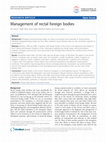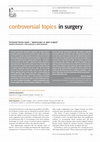Papers by Fevzi Anıl Cengiz
Gastroenterology Research, 2012
Elmer This is an open-access article distributed under the terms of the Creative Commons Attribut... more Elmer This is an open-access article distributed under the terms of the Creative Commons Attribution License, which permits unrestricted use, distribution, and reproduction in any medium, provided the original work is properly cited

Surgical Practice, 2008
Background: Entrapped anorectal foreign bodies are being encountered more frequently in clinical ... more Background: Entrapped anorectal foreign bodies are being encountered more frequently in clinical practice. Although entrapped foreign bodies are most often related to sexual behavior, they can also result from ingestion or sexual assault. Methods: Between 1999 and 2009, 15 patients with foreign bodies in the rectum were diagnosed and treated, at Izmir Training and Research Hospital, in Izmir. Information regarding the foreign body, clinical presentation, treatment strategies, and outcomes were documented. We retrospectively reviewed the medical records of these unusual patients. Results: All patients were males, and their mean age was 48 years (range, 33-68 years). The objects in the rectum of these 15 patients were an impulse body spray can (4 patients), a bottle (4 patients), a dildo (2 patient), an eggplant (1 patient), a brush (1 patient), a tea glass (1 patient), a ball point pen (1 patient) and a wishbone (1 patient, after oral ingestion). Twelve objects were removed transanally by anal dilatation under general anesthesia. Three patients required laparotomy. Routine rectosigmoidoscopic examination was performed after removal. One patient had perforation of the rectosigmoid and 4 had lacerations of the mucosa. None of the patients died. Conclusions: Foreign bodies in the rectum should be managed in a well-organized manner. The diagnosis is confirmed by plain abdominal radiographs and rectal examination. Manual extraction without anaesthesia is only possible for very low-lying objects. Patients with high-lying foreign bodies generally require general anaesthesia to achieve complete relaxation of the anal sphincters to facilitate extraction. Open surgery should be reserved only for patients with perforation, peritonitis, or impaction of the foreign body.

The Annals of The Royal College of Surgeons of England, 2009
Incisional herniation represents a significant, and often underestimated, drawback to invasive ab... more Incisional herniation represents a significant, and often underestimated, drawback to invasive abdominal surgery. With anything up to 20% of patients developing an incisional hernia at some stage postoperatively, the effects on those affected-poor cosmesis, social embarrassment, impaired quality of life-represent a major detriment to the nation's abdominal surgical population, even before the more obvious problems of pain, strangulation and skin erosion are considered. There will be no imminent shortage of patients requesting incisional hernia repair. But how should they be best served? As with other forms of hernia repair, the debate regarding suture versus mesh repair should probably be considered obsolete. But is laparoscopic surgery a reasonable alternative to open mesh repair, or even the preferred solution? Laparoscopic incisional hernia repair is clearly technically feasible, and its potential advantages-reduced postoperative pain, shorter hospital stay, increased patient satisfaction-are clearly enticing. Banerjea and Bhargava cite meta-analyses supporting the benefits of the laparoscopic route, although perhaps of interest is the relative lack of evidence for any significant reduction in recurrence rates. Kingsnorth argues that large and complex incisional hernias, especially those with loss of domain, can only be repaired using open surgery, with component separation techniques facilitating fascial closure and onlay mesh reinforcement. Such hernias probably remain beyond the scope of laparoscopic surgery, but the optimal treatment for smaller hernias remains contentious. As with many other areas of healthcare, prevention-in the form of fewer open and more laparoscopic abdominal proceduresmay be preferable to cure.
Case Reports in Surgery, 2013
Intestinal pathologies due to ovarian cyst are observed rarely. Although a limited number of case... more Intestinal pathologies due to ovarian cyst are observed rarely. Although a limited number of cases in neonatal and adolescent periods have been observed, no adult case has been reported in the literature. Two mechanisms are involved in intestinal complications due to ovarian cysts: torsion due to adhesion or compression of giant ovarian mass with a diameter of 9-10 cm. We report here a terminal ileum necrosis case due to compression by an ovarian cyst with 11 × 10 × 7 cm size in an 81-year-old woman.

Uploads
Papers by Fevzi Anıl Cengiz